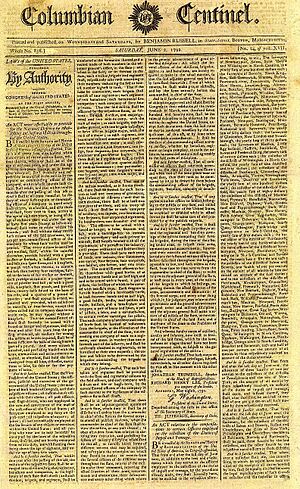Militia Acts of 1792 facts for kids
The Militia Acts were important laws passed by the United States Congress in the early days of the United States. These laws helped organize citizen soldiers, known as the militia, and gave the President of the United States the power to use them to protect the country.
The first two Militia Acts were passed in 1792. They allowed the President to take command of state militias if there was an invasion or a major uprising. This power was temporary, lasting only two years. However, it was used by President George Washington in 1794 to stop the Whiskey Rebellion.
In 1795, Congress passed another Militia Act. This law made the President's power to call out the militias permanent. Later, during the American Civil War, the Militia Act of 1862 changed who could serve. It allowed African Americans to join the militias, not just "free able-bodied white male citizens." This new rule applied to all males between 18 and 54 years old, no matter their race.
Finally, the Militia Act of 1903 replaced the earlier laws. It created the United States National Guard, which became the main organized group of citizen soldiers in the U.S.
Contents
Why the Militia Acts Were Needed
The idea for these militia laws came from similar rules in England from the 1600s. After the American Revolution, leaders like Alexander Hamilton and James Madison thought about how the country should organize its military.
At that time, everyone understood that the President couldn't just call out the militia on his own. He needed a law from Congress to do it.
These Militia Acts became very important after a big defeat in 1791. General Arthur St. Clair's forces suffered huge losses at the Battle of the Wabash. Nearly 1,000 Americans died fighting against a group of American Indian tribes. People worried that the American Indians might attack again while Congress was not meeting. St. Clair's defeat was partly blamed on his army being poorly organized and equipped. Because of this, Congress passed the Militia Acts in May 1792.
First Militia Act of 1792: President's Power
The first Militia Act was passed on May 2, 1792. It gave the President the power to call out the militias from different states. This could happen "whenever the United States shall be invaded, or be in imminent danger of invasion from any foreign nation or Indian tribe."
The law also allowed the President to use militias if U.S. laws were being ignored or stopped by groups too strong for regular law enforcement, like the marshals, to handle. This part of the law was probably thinking about uprisings like Shays' Rebellion.
Before calling out the militia, the President had to make a public announcement. This announcement would order the people causing trouble to "disperse, and retire peaceably to their respective abodes, within a limited time."
The President's power under this act was set to end after two years. However, the Militia Act of 1795 later made this power permanent.
Second Militia Act of 1792: Organizing the Militia
The second Militia Act of 1792 was passed on May 8, 1792. This law focused on how state militias should be organized. It said that every "free able-bodied white male citizen" between 18 and 45 years old had to join the militia.
The law stated: "... each and every free able-bodied white male citizen of the respective States... who is or shall be of age of eighteen years, and under the age of forty-five years... shall severally and respectively be enrolled in the militia..."
Militia members also had to provide their own equipment. This included a musket, a bayonet, a belt, two extra flints, and a box for at least 24 cartridges. Or, they could have a rifle, a powder horn, gunpowder, rifle balls, a shot-pouch, and a knapsack. Some jobs, like congressmen or ferryboat drivers, were excused from serving.
The state militias were organized into different groups like divisions, brigades, regiments, battalions, and companies. The rules from the first act about the President calling out the militia were still in place. If militia members didn't follow orders, they could face a military court.
How the Acts Were Used and Changed
President George Washington was the first to use the Militia Act. In 1794, he called out 13,000 militiamen to stop the Whiskey Rebellion in Pennsylvania.
In 1795, Congress passed the Militia Act of 1795. This law was very similar to the 1792 acts, but it made the President's power to call out militias permanent.
The Militia Act of 1808 later provided money for state militias to buy weapons and equipment. During the American Civil War, the Militia Act of 1862 was passed. This important change allowed African Americans to serve in the militias.
The early Militia Acts didn't fully solve the question of whether the states or the federal government had more control over the militia. This caused problems. For example, during the War of 1812, some New York militia members refused to fight in Canada. They said their job was only to defend their home state. Another time, the Governor of Vermont tried to call his state's militia back from the Battle of Plattsburgh, saying it was illegal for them to fight outside Vermont.
Because of these issues, the federal government started creating "volunteer" units when it needed more soldiers. These volunteers were not part of the regular army or the militia, but they came under direct federal control. This system was used in wars like the Mexican–American War and the American Civil War.
The 1795 act was eventually replaced by the Militia Act of 1903. This law officially created the United States National Guard, which became the main organized military reserve force in the United States.


